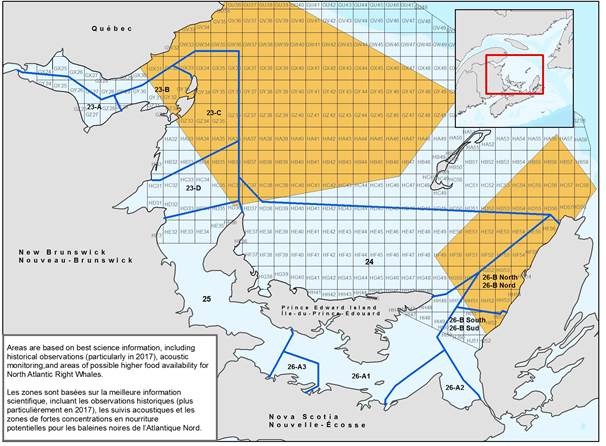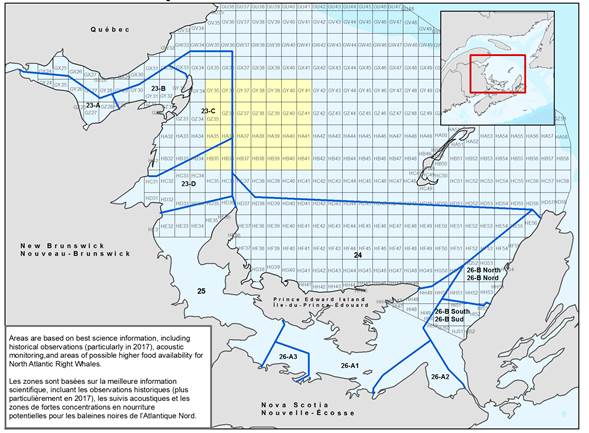Notice to fish harvesters: Lobster conservation harvesting plan – New management measures for 2018 and beyond (LFA 23, 24, 25, 26A AND 26B)
Fisheries and Oceans Canada, Gulf Region, announces the opening of the fishery and new management measures that will be in place in the Lobster Fishing Areas (LFAs) 23, 24, 25, 26A and 26B in 2018. Unless indicated otherwise, existing management measures remain in place.
Opening dates in 2018
The fishery in LFAs 23, 24, 26A and 26B, as per the Atlantic Fishery Regulations, will be open April 30 at 6:00 a.m. and close on June 30 (inclusively), with the exception of a portion of LFA 26A-1 from Point Prim to Victoria, PEI and LFA 26B North which will open on May 7 at 6:00 a.m. and close on July 7 (inclusively). The 2018 fishing season in LFA 25 is tentatively scheduled to open on August 9 at 6:00 a.m., and close on October 10 (inclusively). The openings of the fishery on targeted opening dates are subject to ice and weather conditions.
NEW management measures to be implemented for the 2018 fishing season
Increase in minimum legal size of lobster carapace (previously announced in 2018 by separate Notice to Fish Harvesters)
- 77 mm for all LFA 23, including sub-areas 23A, 23B, 23 C and 23D in 2018
- 73 mm in LFA 24 and LFA 26A-1 in 2018
- 74 mm in LFA 26A-1 in 2020
- 81.7 mm in LFA 26B South in 2018 and to 82.5 mm in 2019
- 77 mm in LFA 25 in 2018
For LFA 24
- All female lobster of a length 115 millimetres (mm) or greater shall be returned to the water immediately in a manner that causes it the least harm.
- A minimum of six traps per line.
North Atlantic Right Whales
A shift in the distribution of the North Atlantic Right Whales (NARWs) population in recent years has resulted in an increased presence of NARWs in the Gulf of St. Lawrence. In an effort to minimize the risks of interactions with this species, other marine mammals and species at risk, Fisheries and Oceans Canada is announcing important management changes in the Gulf Region lobster fishery.
Fishing Gear: Reducing the amount of rope floating on the surface of the water
The following requirements will be in place to minimize the length of rope floating on the surface of the water and to reduce the risks of entanglements:
- No rope attaching a lobster trap to a primary buoy shall remain floating on the surface of the water after the lobster trap has been set.
If using multiple traps per line:
- No rope attaching a lobster trap to another lobster lobster trap shall remain floating on the surface of the water after the lobster trap has been set.
If fishing with a primary and secondary buoy:
- A maximum of 3.7 meters of rope shall be used when attaching a primary buoy to a secondary buoy.
Note: A primary buoy is defined as a buoy or other floating device attached to a trap. A secondary buoy is defined as a buoy or other floating device attached to a primary buoy.
Requirement to report lost gear
Licence holders will be required to report lost gear. This new management measure will help quantify the amount of gear lost annually and identify the need to increase efforts to retrieve gear that has been lost, which would reduce the risks of whale entanglements.The following specific information must be reported to DFO by email (GLF.DFO.Gear-Engins.GLF.MPO@dfo-mpo.gc.ca) within 72 hours of noticing that the gear has been lost:
- sequence number of tag attached to the lobster trap that has been lost
- vessel registration number or vessel identification number in the case of Aboriginal licence conditions:
- latitude and longitude of last known position of lost lobster trap
- date the lobster trap was last fished.
Marine mammal interaction reporting
In order to comply with the implementation of the US Marine Mammals Protection Act (MMPA) regulations, licence holders must now provide information regarding all interactions with a marine mammal including: bycatch, collisions and all sightings of entangled marine mammals that occur during fishing expeditions.
A Marine Mammal Interaction Form (included with licence conditions) must be completed and submitted by email to DFO.NAT.InteractionsMM-InteractionsMM.NAT.MPO@dfo-mpo.gc.ca within 48 hours after the end of a fishing trip.
The information provided on the form will be used by DFO to estimate levels of accidental mortality and injury to marine mammals. This information will allow DFO to better assess the types of threats that may affect Canada's marine mammals and to develop mitigation strategies.
Requirement to report sightings of live whales
Sightings of live, free-swimming whales must be reported to DFO by telephone: 1-844-800-8568, or by email: XMARwhalesightings@dfo-mpo.gc.ca.
Protocol for the dynamic management of the fisheries
DFO will implement a protocol for the dynamic management of the fisheries in 2018 which will close areas to fishing activities when the presence of NARW is observed. This protocol will allow DFO to close specific areas to fishing activities to prevent incidents with NARW, such as entanglements. DFO will use the existing soft shell/white crab grids to close areas due to the presence of NARW. These measures may be adapted as needed over the season.
Observations inside a foraging area for the lobster fishery
When one NARW is observed inside a foraging area (see map below), a maximum of nine grids will be closed to provide a buffer area around the sighting location to account for whale movements.
Closing and reopening of the areas
Closures will be in force for a minimum period of 15 days and will be extended by 15 days from the last NARW sighting. If NARWs are not seen during at least two aerial surveillance flights during the 15 days period, the dynamic closure for the relevant sections will be automatically lifted at the end of the period. Closures will be regulated through variation orders and licence holders will be provided an advance notice of 48 hours to retrieve fishing gear from the area prior to closure.

Static closure
DFO will implement a static closure in an area where 90% of the NARW observations occurred in 2017 to provide a large gear-free area for the NARWs, thus reducing the risk of gear interaction. The closure will be in effect on April 28, 2018 or sooner if NARW are present. This measure may be adapted as needed over the season. The coordinates for the static closure are as follow:
| Points | Latitude | Longitude |
|---|---|---|
| Position (north-west corner) | 48 ° 00 ' 00 ' ' | 64 ° 20 ' 00 ' ' |
| Position (north-east corner) | 48 ° 00 ' 00 ' ' | 63 ° 10 ' 00 ' ' |
| Position (south-east corner) | 47 ° 20 ' 00 ' ' | 63 ° 10 ' 00 ' ' |
| Position (south-west corner) | 47 ° 20 ' 00 ' ' | 64 ° 20 ' 00 ' ' |
| The point references are based on the geodesic system North American Datum 1983 (NAD83). Positions are expressed in degrees, minutes and seconds. | ||

Other management measures which will continue to apply in 2018
Height and length of escape mechanisms
The height of the escape mechanism as indicated in Table 1 needs to be adjusted according to the minimum legal carapace size in effect in each LFA (refer to Table 2 for minimum legal size).
| Length of escape opening between 127 mm and less than 254 mm | |
| Minimum legal carapace size | Height of escape opening |
| >71 mm to 73 mm | 42 mm |
| >73 mm to 76 mm | 43 mm |
| >76 mm | 44 mm |
| Length of escape opening equal to or greater than 254 mm | |
| Minimum legal carapace size | Height of escape opening |
| >71 mm to 73 mm | 41 mm |
| >73 mm to 76 mm | 42 mm |
| >76 mm to 80 mm | 43 mm |
| >80 mm | 44 mm |
| Minimum legal carapace size (mm)Footnote 1 |
Window size females (mm)Footnote 2 |
Maximum number of traps |
Minimum number of traps per lineFootnote 3 |
Maximum hoop size (mm) |
|
| 23A | 77 | 115-129 | 300 | n/a | 152 |
| 23B | 77 | 115-129 | 300 | n/a | 152 |
| 23C | 77 | 115-129 | 300 | In a portion of 23C : 3 traps |
152 |
| 23D | 77 | 115-129 | 300 | In a portion of 23D: 3 traps |
152 |
| 24 | 73 | 115 | 300 | 6 traps | n/a |
| 25 | 77 | 115 | 240 PEI 250 NB 225 Gulf NS |
n/a | 152 |
| 26A-1 | 73 | 115-129 | 272 PEI 280 Gulf NS |
In a portion of 26A-1 adjacent to PEI: 6 traps (extended in 2017) 26A-1 (Gulf NS fishers only): 5 traps |
n/a |
| 26A-2 | 76 | 115-129 | 255 and 275Footnote 4 | 6 traps | 152 |
| 26A-3 | 76 | 115-129 | 250 | 2 traps | n/a |
| 26B South | 81.7 | n/a | 250 | n/a | n/a |
| 26B NorthFootnote 5 | 82.5 | n/a | 250 | 5 traps | 152 |
Restrictions on the movement of lobster licences
For information on restriction on the movement of lobster licences you can refer to the Commercial Fisheries Licensing Policy for Gulf Region.
Logbooks
DFO reminds licence holders that logbooks shall continue to be submitted on a monthly basis. Further logbook details are available in your lobster licence conditions. The list of suppliers is available online.
Daily closed time
The daily close time from 9:00 p.m. to 4:00 a.m. in LFA 23 will remain in 2018. Further details are available in your lobster licence conditions.
Transit corridors
As in 2017, there will be an approximate 200 m wide transit corridor open by Variation Order in LFA 25 from the boundary line of LFA 23/25 to Pointe Sapin, New Brunswick during the LFA 25 closed season allowing fish harvesters to transport their catches through that area (corridor) to reach their homeport and avoid using the smack boat. There will also be a transit corridor open in LFA 23D and one open in LFA 24 during the Fall LFA 25 season to transport their catches through the corridor. For that reason, there will be a validity period added to the LFA 23D, LFA 24 and LFA 25 licences. The season for each applicable LFA remains as listed in the Fisheries Regulations or announced in the Variation Order. A Vessel Monitoring System (VMS) is required if using the transit corridor. The coordinates for the various corridors are included in Variation Orders and/or licence conditions. The coordinates of the corridors are unchanged from 2017.
Before you go fishing
- Date modified: